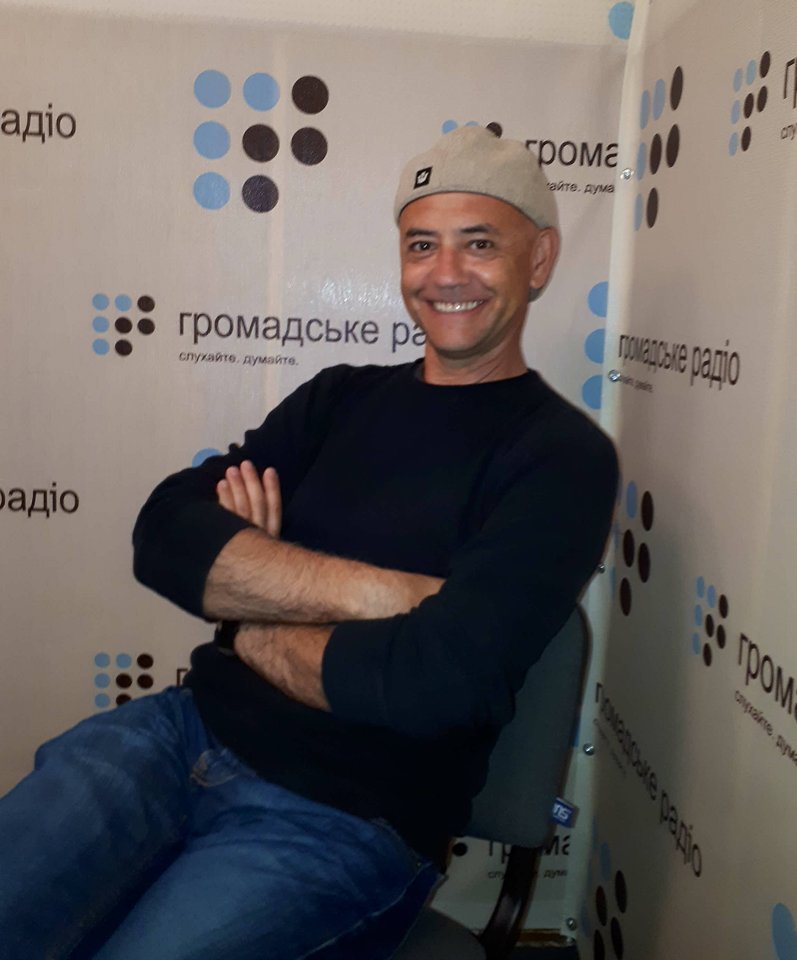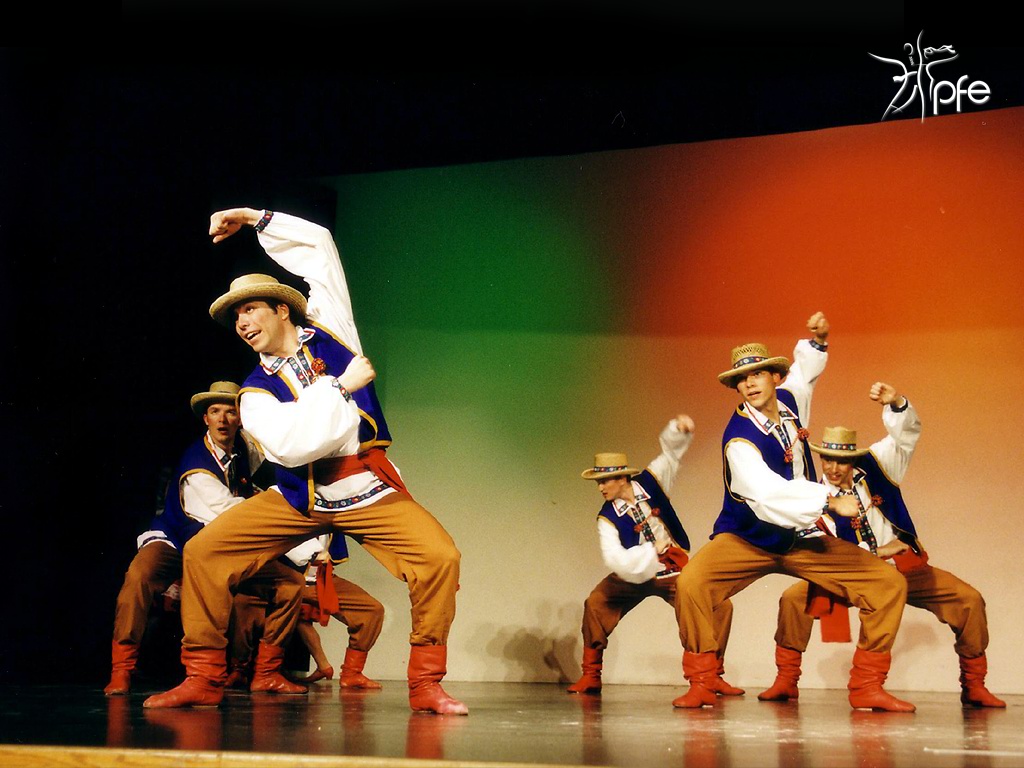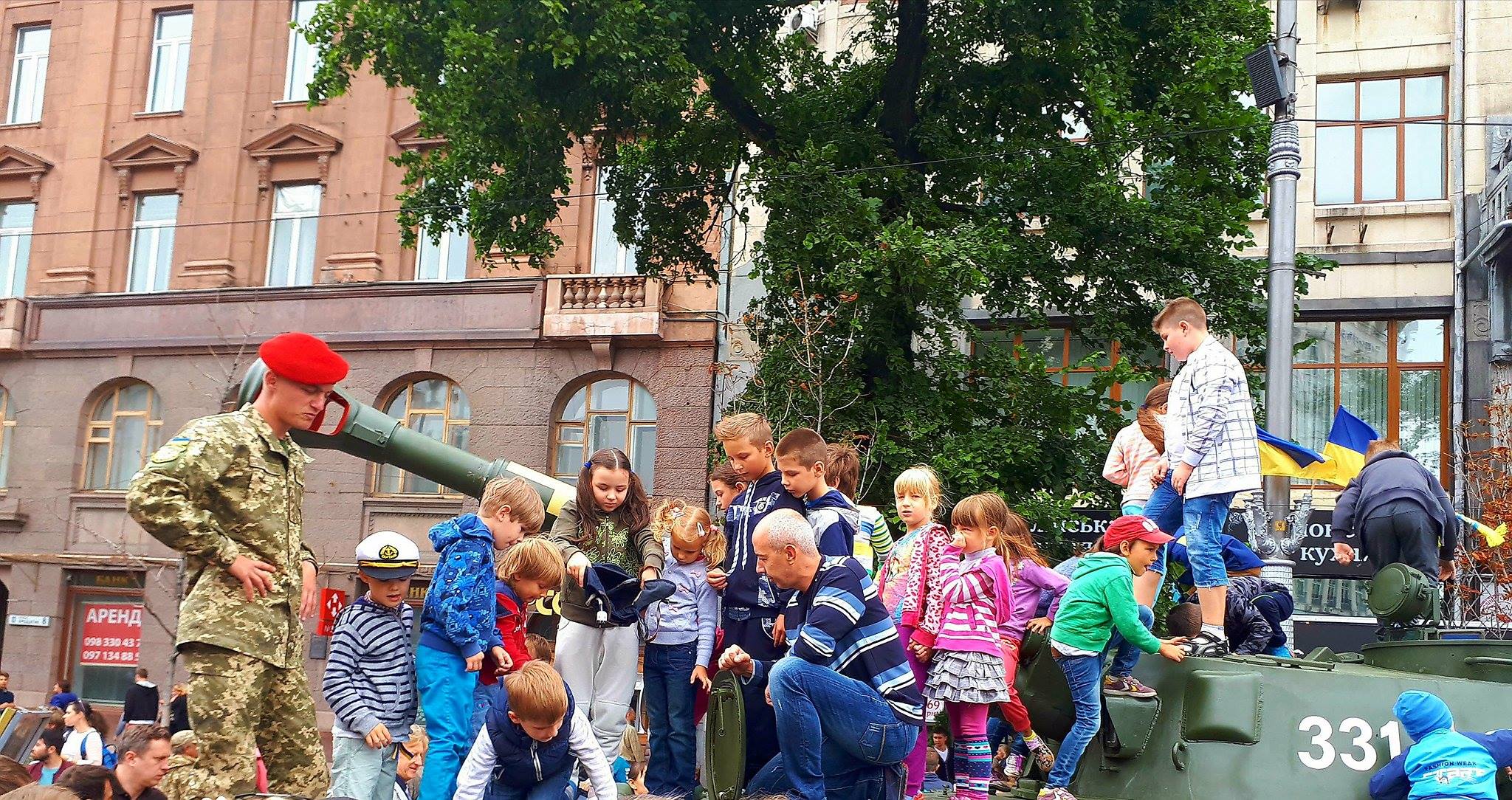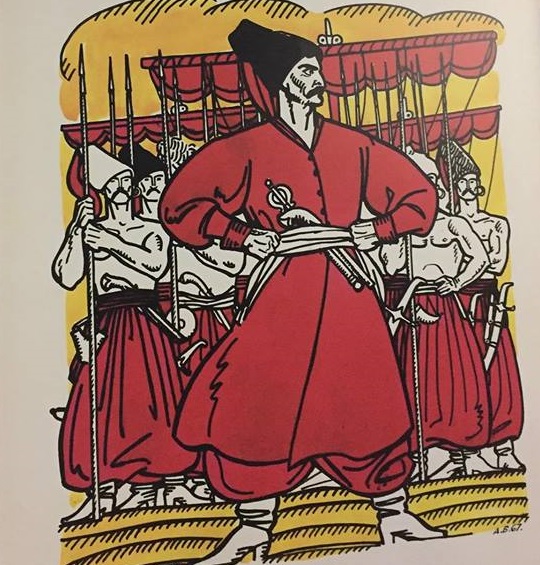
Celebrating Ukrainian Independence and Identity Through Dance
Artistic Director of the Pavlychenko Folklorique Ensemble Serhiy Korolyuk talks to Bohdan Nahaylo about the Power of Dance

Hello and welcome to this week’s Ukraine Calling programme. I’m Oksana Smerechuk for Hromadske Radio in Kyiv.
Feature Interview: Artistic Director of the Pavlychenko Folklorique Ensemble Serhiy Korolyuk talks to Bohdan Nahaylo about the Power of Dance
NEWS
CULTURE and MUSIC
LOOKING FORWARD
Hromadske Radio is independently funded. We are appealing for funds through a crowd funding initiative. Should you feel inclined to donate, you can do so here using Wayforpay.
Feature Interview: Artistic Director of the Pavlychenko Folklorique Ensemble Serhiy Korolyuk talks to Bohdan Nahaylo about the Power of Dance
Nahaylo: Welcome to our in-depth discussion this week for Ukraine Calling on Hromadske Radio. This week we are celebrating the 26th anniversary of Ukrainian Independence and of course attention is focused on politics, on the war that’s continuing in the east, but the glue, if you want, that has kept us together all these many centuries is culture and a sense of a shared past. And today I’m going to be talking to a man who started off in Ukraine but has ended up as the artistic director of the Pavlychenko Folklorique Ensemble in Saskatoon. I’m going to ask him about the state of Ukrainian dance, its place in our culture, in our revolving culture, and his perceptions on where things are generally in Ukraine after a successful tour here with his Pavlychenko Folklorique Ensemble. So Serhiy Korolyuk, the artistic director of the Pavlychenko Folklorique Ensemble, welcome to our show.
Korolyuk: Hello!
Nahaylo: First question: So what brings you to Ukraine this time around?
Korolyuk: Well, this time we are participating in, I think, the second International Festival of Ukrainian culture and dance in the city of Lviv. Also we had as a group – PFE or Pavlychenko Folklorique Ensemble—had a tour to Balkan countries. So we visited and performed in Croatia, Bosnia, Serbia, and we also visited Budapest, Hungary.

Nahaylo: Impressive! Quick question: was there interest? Did you attract the audiences that you wanted?
Korolyuk: Yes! Actually we were very well received. It’s a hot season now and lots of tourists and we had basically full houses.
Nahaylo: But these weren’t just Ukrainians?
Korolyuk: No, no, no, not at all. Actually one performance we had at town of Kula, Serbia, that’s an area where Ukrainian immigrants are located, and Ruski Krstur area, that’s Rusyny, that’s where most of the Ukrainian diaspora lives in Serbia. But in Croatia, like Makarska, for example, or Neum in Bosnia, there were mostly international tourists and people from all over Europe.
Nahaylo: Okay, before we go on to discuss what you’ve been up to in Ukraine, let’s pause and talk a little bit about the Pavlychenko Folklorique Ensemble. Now, I’m lucky enough to know Saskatoon where you’re from in Saskatchewan. My first wife was from that province and I’ve seen your Ensemble perform many times, but tell us and our audience a little bit about this now-legendary state of the art Ukrainian-Canadian folklorique ensemble. When was it founded?
Korolyuk: That’s a very good question Bohdan. The Ensemble was founded fifty years ago in 1967 to be exact. It was founded by the late Lusia Pavlychenko and this year we celebrate our fiftieth anniversary, so it’s a very special year for us.
Nahaylo: Tell me, was she born in Canada or was she one of the newly arrived after World War Two?
Korolyuk: No, Ms. P, or Lusia, she was a kid of immigrants. So her parents were both born in Ukraine but Lucia and her two sisters, three kids, were born in Saskatoon, Canada.
Nahaylo: And what’s the secret? How has this Ensemble managed to keep going and be so successful for half a century?
Korolyuk: Well, first of all I would say Lusia was a very passionate person, and very artistic. So she attracted lots of dancers. But the main boost, and root of it, I would say is the big Ukrainian community in Canada, especially Western Canada. And Western Canada, I’m talking about Saskatchewan, Alberta, Manitoba, those provinces actually last year we celebrated 125th anniversary of Ukrainian settlement in Canada. 125th anniversary! That tells…
Nahaylo: That’s impressive.
Korolyuk: That’s impressive! Down east, Ontario, I would say there is the newer generation. That’s mostly the immigration,
Nahaylo: After World War Two.
Korolyuk: Correct, yes, so the Canadian prairies, those three provinces, Ukrainians have been there for four generations. In Saskatchewan, I believe, 14% of the population of Saskatchewan identify their,
Nahaylo: Their origins as Ukrainian.
Korolyuk: Correct, yes.
Nahaylo: Tell me, now I know that there were very strong dancing groups in Winnipeg Rusalka and Shumka in Edmonton
Korolyuk: In Edmonton, yes.
Nahaylo: And certainly in Toronto and elsewhere. What is the state of play now? Are there still as many good dance ensembles in Canada?
Korolyuk: There are. And since my time being in Canada,
Nahaylo: You were invited from Ukraine as a professional dancer and choreographer?
Korolyuk: Correct. I assisted Pavlychenko in 1992 to organize and manage their tour in Ukraine.

Nahaylo: You were trained in Kyiv.
Korolyuk: I was actually at that time the choreographer and artistic director of dance group for Bukovyna State Song and Dance Company under the Chernivtsi philharmonic umbrella. So I was a ballettmeister, they call it, or a dance director.
Nahaylo: You must have been very young.
Korolyuk: I was actually. Back then I think I was the youngest choreographer. I was 28 when I took the position and that was quite something for those days in Ukraine. And from this appointment…and I also taught the choreography in Ukrainian dancing at College of Performing Arts in Chernivtsi as well. So then we met with the company and I also had done workshops for them, conducted workshops there. And then Lusia, their artistic director, asked me and said, “Serhiy, would like to come to Canada and expand the repertoire of Pavlychenko?”
Nahaylo: And one of the secrets of the success of this ensemble and others like it is that you already prepared a new generation. You were constantly taking in young cadres, teaching them and that they could take over in time from those who were too old or got married, left, or whatever.
Korolyuk: Absolutely, usually dancer’s participation in the company I would say is an average of five to six years, so then you always have to rejuvenate and the new people come. But what I was trying to say Bohdan is that since my time, see it was twenty-four years ago actually when I came to Canada, I see progress. You ask me what is the stage: is it stuck, is it growing? It is growing.
Nahaylo: Is it an exercise in conservation or is it something that is evolving?
Korolyuk: It’s absolutely “yes.” It’s evolving and quite dynamically. For the last almost quarter-century I see progress. But we’re talking about staged version of folk dance, right? Where there is choreographer and artist that design dance based on the folk steps, stories, regions etc. and create a piece, right? But the folk dance itself and especially Ukrainian folklore have been in Canada before as well. People who emigrated from different countries, not just Ukraine, brought their dances with them, they brought their trunks, Baba’s trunk. Actually one composition I called “Baba’s Trunk” when the dancers bring on stage a trunk and they open it and take out pieces and tell the story through the dance about those pieces.
Nahaylo: Pandora’s box from Ukraine…
Korolyuk: Baba’s Trunk not Pandora’s! Well, I guess you could tell. Well what I am saying is that folk dance in this form is still there as well and was there. And I will say that dance probably the most convenient form for people to keep their culture and to recognize themselves as Ukrainians because language is of course generation after generation is declining. In the west we speak English mostly. But dance… it’s a movement. That’s why I think probably lots of young people would like to demonstrate their Ukrainian roots through a form of dance. They shouldn’t have to speak but you can just express.
Nahaylo: But one of the fascinating things of watching the Pavlychenko ensemble’s development over the years and of similar groups over the years you have not just ethnic Ukrainians dancing for you. It’s been a magnet for others living in the area. One of your protégé, a young woman Lana, who was not Ukrainian by origin and who ended up dancing for Virsky Studio in Ukraine.
Korolyuk: That’s correct. I do have non-Ukrainian dancers or I call them “Ukrainian Light” because in their soul, their spirit they just love this genre, love this culture and they have become part of this culture. I love them. It’s not just mama sent a kid to take classes. They really wanted to do it.
Nahaylo: They were not forced to do it like some of …
Korolyuk: Lana Kuban. A good example… But she also took jazz, ballet, Ukrainian dance. She is multitask and versatile dancer.
Nahaylo: Now I hear one of your students is trying out with Virsky Studio. The first male they have taken from outside.
Korolyuk: Yes, Markian Duplak, one of main lead dancers. Now he is entering Virsky Studio.
Nahaylo: Maybe not everybody knows, Virsky Studio is the best state ensemble of Ukraine.
Korolyuk: Not just of Ukraine. I think it’s the best Ukrainian dance ensemble in the world. It’s the highest level in the genre you can reach.
Nahaylo: Looking at dance in Ukraine, at Virsky and other regional groups, are they into conservation or are they also expressing creativity that helps them to develop and keep up with the times and attract new audience from the new generation that is growing up?
Korolyuk: I would say it depends…
Nahaylo: Or the question is two-fold: to conserve the best and develop new things.
Korolyuk: I think they started as a preservation. I f you look at their statements “to preserve art of Ukrainian dance.” It also depends on the vision of choreographers and directors. I would say that bigger companies have access to information, education, or more creative approach. It’s definitely moving forward. Some groups are usually in smaller towns, because Ukrainian dancing in Western Canada is basically everywhere from small towns to big cities.
Nahaylo: And every wedding…
Korolyuk: Yes, and every wedding. It’s like no questions asked…
Nahaylo: Pandemic.
Kolorlyuk: And kolomyjka and zabava are part of Canadian Ukrainian life. Big time. I would say that some groups are just trying to preserve. But still they develop in a way. I see now they are presenting different regions. I remember when I came to Canada 24 years ago there were presented just Poltava and Hutsul, for example, two regions, West and East or Central Ukraine to be more exact.
Nahaylo: Hopak and arkan.
Korolyuk: Now you can see Bukovyna, Polissia, Volyn, Podillia. It shows us that the range is expanding. It means they are developing. There is evolution. Even it’s a staged form, it’s not authentic folk, but it’s moving ahead.
Nahaylo: Personally I respect forms of folk dance as a historical base, as a museum exhibit. That should stay for people to look and enjoy with a nostalgic beauty, etc., but also…
Nahaylo: A cultural reference…
Korolyuk: Correct. But also today we are folks as well that is what folklore is. We have to think about every generation should add to this more, and more, and more. My dancers love Ukrainian dance not just because it’s a history or it’s a past but because it’s interesting today. Today’s expression that what they like. I created dance called holubka, holubka fusion based on old Pokuttia dance holubka and the music I chose was from rock band VV, Vopli Vodopliasova, and the dance was executed in everyday costumes (clothes), like a typical Canadian Ukrainian zabava. Ladies dress up in high heels, and men dress up in shirts and ties, but the holubka dance is new version of what young people today. That’s a reflection of today’s folklore.
Nahaylo: Can we imagine a time when we see dancers of the Zaporizhzhia kozaks going off to battle etc. are going to have dances in the future dealing with the ATO [Anti-Terrorist Operation, one way that the war in Donbas is called], with Orange Revolution or the Revolution of Dignity? Or is that something too complex? Maybe that is something for a show, a kind of a musical as opposed to one dance?
Korolyuk: Very good point, Bohdan. I think as a genre, as a form of dance like hopak for example among Zaporozhtsi, which may have started from military training and especially male technique can tell those steps are from martial arts. Hopak is a combination of martial arts and …
Nahaylo: And cultural self-expression, if you want…
Korolyuk: Right. But with ATO… Will it reflect on a repertoire of groups? I would say “yes”, and this theme would be probably more and more expanded. But will it turn into different form of dance? I’m not sure. We have a number of “Departing kozaks.” My group even brought it to Ukraine this year. A number dedicated to Ukrainian soldiers and their loved ones. It’s called “Departing kozaks.”
Nahaylo: Now that we are in the process of creating this political nation of citizens, will we also see Crimean Tatar dances occasionally in the repertoire or Jewish or Polish or something? Because the tradition here has been to in the Soviet period to have dances from neighbouring republics. Moldovan dances, Russian dances, Belarusian, do we foresee that in concerts in the repertoire a quarter or a fifth will be devoted to the national minorities or not?
Korolyuk: I would say it would probably and it should. If you look in Western Ukrainian regions – Zakarpattia, Bukovyna, you’ll see an influence of Romanian, or Slovak, or Hungarian, or Polish, Volhynia, Polissia style of dancing and that’s what makes Ukrainian dance very versatile and interesting from region to region. Same in the south- Tatar, Bulgar, Greek, Jewish dance. It’s a part of Ukrainian culture, of Ukraine as a whole. Are we going to see this in the diaspora in Canadian groups? I would wait and I wouldn’t say so. But in Ukraine, I think, that is the way to do it and expand this vinok – so to say – wider.
Nahaylo: To conclude, we started off by saying that you are here to attend this festival in L’viv, and I note that apart from your group from Canada, Pavlychenko Folklorique Ensemble. Interestingly ‘folklorique’ is in French; ‘ensemble’ is in English, I suppose;
Korolyuk: Correct.
Nahaylo: Pavlychenko is Ukrainian; multicultural Canada in the title, deliberately I suppose.
Korolyuk: That’s correct. That’s the philosophy.
Nahaylo: Okay, but I notice that there is also a dancing ensemble from Argentina.
Korolyuk: That’s correct, Prosvita from Argentina, Cheremosh from Minneapolis, United States, Volya Choir from United Kingdom. We had five companies from Canada, Edmonton’s Shumka School of Dance; Winnipeg’s Troyanda and Sopilka; Saskatoon’s PFE.
Nahaylo: Amazing. Your final comments as we mark 26 years of Independence. It seems like this one concert in your presence symbolizes that continual unity of the motherland and its children, the diaspora, despite all the trials and tribulations that this country faces.
Korolyuk: Absolutely, we trying to actually show our support, and for the students in the diaspora, the dancers, to bring them closer to learn more about the country of their ancestors, and most of all, be in Ukraine, and show our support for Ukraine at this very time.
Nahaylo: Serhiy, on a personal note, do you get a high coming back to Ukraine, attending these festivals, being in the center of things, bringing your young people over and putting them on display for Ukrainians in Ukraine?
Korolyuk: Am I what?
Nahaylo: Do you get a high, are you excited, do you get satisfaction?
Korolyuk: Yes, I do, and you know what, Bohdan. When I saw my dancers after we performed in L’viv–
Nahaylo: How many are there?
Korolyuk: Performing this year, there are 30 dancers, I took 38, but 30 of them are performing this year. We had a show, as I mentioned, in Croatia and Bosnia, but in L’viv they did their first show on ‘ploshcha,’ the market square, on the outdoor stage, and I went backstage and I saw my dancers sweating and also crying. I said ‘what’s wrong?’ It was tears of happiness, and for them it was very special. It makes me feel that dance is the great art, a bridge from one heart to another and nothing will substitute that.
Nahaylo: Thank you, Serhiy, for that very nice poetic ending and summary. I have been talking to Serhiy Koroliuk, the artistic director of the Pavlychenko Folklorique Ensemble from Saskatoon, Saskatchewan, Western Canada. I wish you and your ensemble great successes.
Korolyuk: Thank you, Bohdan.

NEWS
Independence Day
Ukraine celebrated 26 years of independent statehood this week. The Ukrainian Parliament declared independence from the USSR on the 24th August 1991. On this year’s anniversary, a large-scale parade was held in the capital Kyiv to mark the occasion, with the presence of top Ukrainian govеrnment officials and foreign dignitaries. The parade included Ukrainian troops from all divisions marching along the central street Khreshchatyk. For the first time soldiers from 8 NATO countries joined the Ukrainian Armed Forces in the parade, in a strategic display of support. There was also a exhibition of military equipment currently in use and produced in Ukraine, located at European Square, at one end of the parade route.
President Poroshenko spoke during the event, noting that “our international partners will understand from this parade that Ukraine is capable of defending itself… Our parade is a signal to the enemy, that Ukrainians are ready to keep on defending their independence.”
He also stated that the 26th year of independence was notable, in that Ukraine had set a definite course towards membership of the European Union and membership of NATO.
Visit of US Secretary of Defence Mattis
US Secretary of Defence James Mattis made a visit to Ukraine, confirming US support to the country. At a press conference on August the 24th, he stated that one should “have no doubt. The United States stands with Ukraine”. He also repeated that, “We do not, and we will not, accept Russia’s seizure of the Crimea. And despite Russia’s denials, we know they are seeking to redraw international borders by force.”
On supplying Ukraine with lethal defensive weapons, he confirmed that that is an issue which Washington is “actively reviewing.” He justified this by further stating: “Defensive weapons are not provocative unless you are an aggressor, and clearly Ukraine is not an aggressor since it is their own territory where the fighting is happening”
President Poroshenko, in turn, stated that he was satisfied with the progress on discussions about weapons.
The War
The military situation on the front over the last week has been at a stalemate. On August 20th pro-Russian forces reportedly attacked residential areas of the village of Zaytseve in Donetsk region. On August 21st shelling of the village of Zhovanka in Donetsk region caused fire damage to local properties. According to the Ukrainian Ministry of Defense, pro-Russian forces have a “scorched earth policy” to destroy infrastructure around the city of Mariupol and to set forests and crop fields on fire. Over the last week, 1 Ukrainian serviceman was killed in action and 18 wounded.
Cease-fire again
Telephone consultations were held with the leaders of the Normandy format on August the 22nd. The Ukrainian President conferred with the President of France, the Chancellor of Germany and the President of Russia.
As a result, they expressed their support for the Trilateral Contact Group to announce a cease-fire on the occasion of the beginning of the school year. This would allow the children of Eastern Ukraine to be able to attend school. The President’s office said that: “the truce will lead to a sustainable improvement of the security situation to benefit schoolchildren and the entire civilian population of the Donbas”.
A number of cease-fire agreements have been announced since the Russian-backed forces seized parts of the Donbas region in 2014, but none has been proven to be sustainable.

No More Lenin
British media have been noticing Ukraine’s progress in making post-Soviet reforms. This week both The Times and the Independent featured articles commenting on the vanishing statues of Lenin and other communist symbols. Since Ukraine passed a law on De-Communisation in May 2015, there has been a government-led drive to remove Soviet symbols in Ukraine. According to Ukraine’s Institute of National Remembrance, in this period, 1,320 Lenin statues have been taken down as well as 1,069 other Soviet-era monuments. The renaming of a large number of streets has also been a part of this process.
CULTURE
There were many cultural events this week inspired by Independence Day celebrations. A new exhibit at the National Museum of Art in Kyiv called ‘Project Aeneid,’ a tribute to the father of Ukrainian literature Kotliarevs’kyi. It features many of Ukraine’s outstanding artists over the past century, who illustrated Kotliarevsky’s best-known epic poem, like Narbut, Bazylevych, Levytskyi, Kirych and others.
New Films premiere. Including ‘Chervonyi’ (Red) a docudrama set in 1947 about a Ukrainian freedom fighter pitted against the Soviet system. It’s based on a novel by Andriy Kokotiukha and was entered in the 2017 Oscar competition.
The respected music web site Karabas has released a list of the top 100 songs released in Ukraine since independence in 1991. There’s a lively discussion in Kyiv about the choices so we’ll post a link on our website and let you decide for yourself:
MUSIC
One of the most powerful songs coming out of Ukraine over the past few years is by FOMA called ‘Hrady Vohniani.’ The title translates as Fiery Hail. Hrad is a play on words here. It means hail, and is the name of the Soviet-era multiple rocket launch missiles GRAD that have been bombing eastern Ukraine for over 3 years. The song was performed by FOMA in Toronto in spring of 2015, not long after the battle over Dontes’k airport had inspired the song. On the occasion of the 26th anniversary of modern independence FOMA released video to go with the song. It has has black and white images and video of soldiers who have been on the front, some of whom have been killed. FOMA, by the way, is the author of the jingle you hear opening Hromasdke Radio Ukraine Calling every week.’
LOOKING FORWARD
Ukraine Calling will be taking its annual end of summer break next week. We’ll be back after Labour Day on September the 8th with a new show for you. Enjoy the last days of summer. To join our mailing list please write to us at: [email protected] Or just write and let us know what you think. This is Oksana Smerechuk in Kyiv. Thanks so much for listening.
Interview transcribed by Caroline Gawlik, Larysa Iarovenko,and Nykole King. War by Max Sviezhentsev. Info about Crimea by Elvira Saale. News by Oksana Smerechuk and Marta Dyczok. Music by Marta Dyczok. Sound engineer Andriy Izdryk. Web support Kyrylo Loukerenko.


